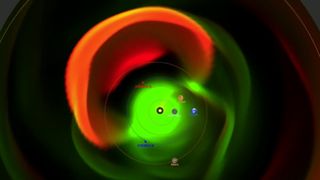Giant Sun Storm of 2012 Shown in Fiery Detail (Video)

NASA released an amazing video that shows the awesome and potentially devastating force of the sun in action.
The sun regularly spits outs fiery clumps of plasma that are held together by magnetic fields. These clumps of plasma are called coronal mass ejections (CMEs), one of the most extreme forms of space weather. A typical CME travels at around 1 million mph (447,040 meters per second) and weighs about 2 trillion tons.
But in 2012, the sun unleashed a CME much larger than the average, and it barreled through space at a staggering 6.7 million mph. NASA officials called it the "perfect storm of plasma" and it would have wreaked havoc on the Earth if it had been aimed at the planet, according to the video released by NASA's Goddard Space Flight Center. [Biggest Solar Flares of 2014: Sun Storm Photos]
To create the video, astronomers combined data collected from several different solar-spotting satellites, and it's now clear just how mind-bogglingly huge and fast the 2012 CME was compared with an average CME. One of NASA's twin Stereo satellites was orbiting ahead of Earth and one was orbiting behind Earth when the massive CME flew by. The Stereo satellites are equipped with coronographs that block out the blinding solar disc and make the corona visible. In the video of the approaching blast captured by Stereo-A, the stream of high-energy particles looks like a snowstorm.
NASA's Solar Dynamics Observatory (SDO) captured the very beginning of the eruption in several different wavelengths of ultraviolet light. Astronomers also collected data on the CME using the joint NASA and ESA Solar and Heliospheric Observatory (SOHO) that has had eyes on the sun since 1995.
By piecing together different views and data, NASA scientists assembled a picture of what the CME looked like as it erupted from the sun and shot out into the cosmos. Astronomers used computer models to reconstruct the whole span and shape of the CME. The model shows that a few smaller CMEs, including one aimed at Earth, preceded the huge one. It's obvious in the video how much larger and faster the main CME was compared with its tinier predecessors.
CMEs are much more powerful than storms like the one that was headed toward Earth in September. Solar flares can cause radio blackouts and spectacular auroral displays. CMEs can have more serious consequences. They can trigger long-term power blackouts, send dangerous electrical currents through oil and gas pipelines, and throw off GPS signals.
Get the Space.com Newsletter
Breaking space news, the latest updates on rocket launches, skywatching events and more!
Follow Kelly Dickerson on Twitter. Follow us @Spacedotcom, Facebook or Google+. Originally published on Space.com.
Join our Space Forums to keep talking space on the latest missions, night sky and more! And if you have a news tip, correction or comment, let us know at: community@space.com.

Kelly Dickerson is a staff writer for Live Science and Space.com. She regularly writes about physics, astronomy and environmental issues, as well as general science topics. Kelly is working on a Master of Arts degree at the City University of New York Graduate School of Journalism, and has a Bachelor of Science degree and Bachelor of Arts degree from Berry College. Kelly was a competitive swimmer for 13 years, and dabbles in skimboarding and long-distance running.
Most Popular

